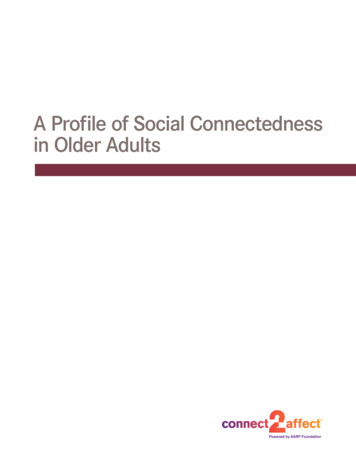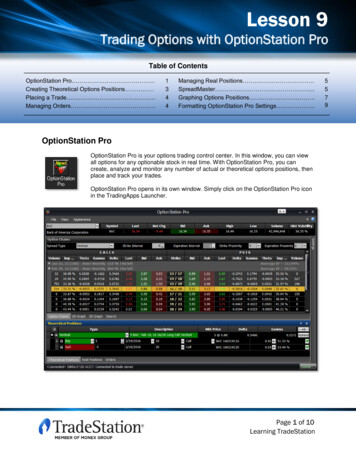
Transcription
A Profile of Social Connectednessin Older Adults
RESEARCHERSAcademic Research CentersNORC @ the University of ChicagoLouise C. Hawkley, Ph.D.Michael Kozloski, Ph.D.Jaclyn Wong, M.A.This report was created with support fromAARP Foundation.The National Social Life, Health and AgingProject is supported by the NationalInstitute on Aging and the NationalInstitutes of Health(R37AG030481; R01AG033903).The content is solely the responsibility ofthe authors and does not necessarilyrepresent the official views of the NationalInstitutes of Health.
FOREWORDLoneliness has been associated with increased mortality and a range of adverse healthoutcomes that are both prevalent and costly in older age. Loneliness, however, is often a hiddenproblem. It has few clear outward indicators, some degree of stigma attached, and no provensolutions beyond conventional wisdom about trying to make friends and find meaningful pursuitsand activities.This report, developed with AARP Foundation support, examines the best existing data toestimate frequency of loneliness among older adults in the U.S., as well as to identify both thecharacteristics of lonely older adults and the segments of the older adult population who are athigh risk for loneliness.It is important to note that loneliness and isolation, although closely related, are not the samething. We can’t confuse social isolation — an objective lack of social networks and access toinformation and resources — with the subjective condition of loneliness. Both are critical andrequire our sustained attention. The scope of this report is specific to loneliness in adults age62–91.Loneliness and isolation in older adults are fairly new research topics. What data there isindicates that these conditions lead to dramatic decreases in physical health, mental well-beingand overall quality of life. More research is needed to fully address this growing — and ofteninvisible — public health threat.It is crucial that we identify who is at risk or already suffering in order to develop effectivestrategies that meet older adults’ need for social connection. Any new research should includeexamining the incidence and effects of loneliness and social isolation on groups that are oftenmarginalized.Through research and ongoing collaboration, AARP Foundation is working to create a deeperunderstanding of loneliness and isolation, draw much-needed attention to these issues andcatalyze action.With warm regards,Lisa Marsh RyersonPresident, AARP Foundation1
EXECUTIVE SUMMARYThis report examines the social connectedness of older adults in the United States. Socialconnectedness is here defined as satisfaction and contentment with one’s social life. Itsopposite, loneliness, is defined as dissatisfaction with the quantity or quality of one’s socialrelationships. Social isolation, or being alone, is related to loneliness but is not the same asfeeling alone, which we call loneliness.Loneliness, in addition to making people’s lives miserable, has been associated with increasedmortality and a range of adverse physiological and health outcomes that are prevalent andcostly in older age. The scope of the problem is related to the prevalence of loneliness in olderadults in the USA, and current estimates of prevalence are not yet available. Relatively recentdata are available, however, and this report uses those data to estimate prevalence. Moreover,characteristics of lonely older adults are not well understood, and segments of the current olderadult population who are at high risk for loneliness have not been identified. This reportaddresses these issues.Data derive from the National Social Life, Health and Aging Project (NSHAP), a panel studyfunded by the National Institutes of Aging (NIA) in which a population-based sample of 3,240older adults was surveyed in 2010 when participants were 62–91 years of age. Results showedthat 19% of older adults in the United States suffer from loneliness; 8% of older adults often feellonely, and 11% feel lonely at least some of the time.Socioeconomic and demographic characteristics differ between the socially connected groupand the lonely group, as do health, social engagement, social network characteristics, andpositive and negative qualities of relationships. Relative to the socially connected group, thelonely group has lower household income and less wealth, is less likely to be married, and livesalone. The lonely group also has poorer self-rated health, more physical limitations in carryingout the activities of daily living, and fewer friends. They socialize, volunteer, attend religiousservices, and participate in organized groups less frequently than the socially connected group.In addition, the lonely group reports less support and greater strain in their relationships withfamily and friends.Data about the older population in general can be used to identify which individuals may be atparticular risk for loneliness. In this nationally representative sample of older adults, the risk ofloneliness is higher for those who do not have a spouse or partner, socialize less frequently,have fewer friends, or experience greater strain in family relationships. Having information onthese four aspects of older adults’ lives significantly increases the likelihood that individuals canbe identified as either lonely or socially connected.The ability to predict which individuals are lonely or socially connected can be further improvedby considering married and unmarried older adults separately, in part because the married andunmarried groups differ in more ways than marital status. For instance, married older adults aremore likely to have a higher income than those who are not married. When examinedseparately, 14% of married older adults and 30% of unmarried older adults fall into the lonelygroup. Married women are at higher risk of loneliness than married men, but unmarried womenare at lower risk of loneliness than unmarried men. In addition, the subgroup most at risk ofloneliness among married older adults includes those who have lower income, attend religious2
services relatively infrequently, and experience poor marital quality. Among unmarried olderadults, the most at-risk subgroup includes those who have more physical limitations, fewerfriends, and greater strain in their family relationships.It is important to note that some of the risk factors for loneliness are also consequences ofloneliness. For instance, loneliness is reciprocally related to physical limitations; not only arepeople with physical limitations more likely to experience the onset of loneliness or increase inits frequency, but loneliness also predicts an increase in functional limitations over time (Luo,Hawkley, Waite, & Cacioppo, 2012). Similarly, strain in family relationships can lead to feelingsof loneliness, but loneliness can also make a person an unpleasant interaction partner, therebyincreasing strain in relationships. These issues are not addressed further in this report, but drawattention to the need for longitudinal research to untangle the temporal ordering that linksloneliness and its various causes and consequences.In sum, although most older adults in the USA are socially connected and seemingly resilient tothe losses that come with aging, a sizeable portion of this population feels lonely. Data identifiedsegments of the population that may be at particularly high risk of loneliness. This informationmay be useful in setting directions for future research, targeting policies, and helping serviceagencies reduce the burden of loneliness in a growing older adult population.3
INTRODUCTIONSocial relationships are important to quality of life across the lifespan, and can bestow life withmeaning, purpose, and a general sense of well-being. Conversely, the loss or deterioration ofimportant relationships to death, poor physical or cognitive health, or geographic relocation takea toll on well-being. Older adults are especially likely to experience age-related losses that affecttheir social relationships. Are older adults socially resilient? Do they manage to find contentmentwith their social life despite the losses and challenge that accompany older age?One way of determining whether individuals are content with their social life is to assess howlonely they feel. Loneliness is the distressing feeling people experience when their social needsare not satisfied, either in number of social ties, frequency of interactions, or quality ofrelationships. Loneliness is not the same as being socially isolated or alone. Some people liverelatively solitary lives and do not feel lonely, while even those with an active social life can feellonely. On the whole, however, deficits in social relationships and frequencies of socialinteractions and activities increase vulnerability to feelings of loneliness. Although number ofrelationships matters to some extent, the quality of the relationships matters even more.Loneliness can be measured by simply asking people how lonely they feel, but the stigmaassociated with admitting loneliness can bias responses. An alternate validated strategy used inthis study is to ask people how often they feel isolated, left out, and lacking in companionship.Recent research has highlighted the dangers of an impoverished social life and the adverseconsequences of poor social relationships and loneliness in older age (Holt-Lunstad et al.,2010). Loneliness has been associated with earlier mortality (Holt-Lunstad et al., 2015), largerage-related increases in blood pressure, increases in depressive symptoms, worsening of sleepquality, altered regulation of the cortisol stress system, and greater cognitive decline (reviewedin Cacioppo & Cacioppo, 2014; Hawkley & Cacioppo, 2010). Preventing and reducing lonelinesscould not only benefit the health and well-being of older adults, but could also have economicimplications for a society with a rapidly growing older adult population. The current scope of theproblem of loneliness in older adults is largely unknown, however.The present report (1) estimates the frequency and prevalence of loneliness, (2) characterizeshow lonely individuals differ from socially connected older adults, and (3) identifies uniquefactors that indicate the segments of the older adult population that are at particular risk forloneliness. The data derive from the National Social Life, Health and Aging Project (NSHAP), apanel study of a population-based representative sample of community-dwelling older adults inthe United States and funded by the National Institute on Aging. Respondents were firstinterviewed in 2005 at 57–85 years of age, and then again in 2010. Spouses and cohabitingpartners of primary respondents were added to the sample in 2010, resulting in a final ageeligible sample of 3,240 adults age 62–91.4
KEY FINDINGSThe NSHAP sample is described in Table 1 (see Appendix) for each of the variables consideredin subsequent analyses. Briefly, the sample has a mean age of 72.2 years, roughly half arefemale (52.6%), most are white (81.4%), most are married (63.5%) or widowed (21.4%), andmost are retired (65.7%). They rate their health as good to very good, and most report nolimitations to everyday activities (67.2%). They are fairly socially active, with roughly half thesample reporting at least weekly socializing with friends and attending religious services.Respondents report better than average support from family members and friends, and marriedrespondents report high levels of spousal support and marital satisfaction. Strain in socialrelationships is low overall, but strain increases with increasing relational closeness; spousalstrain is highest, followed by family strain and then strain in friendships.NSHAP is a representative sample of the U.S. population as a whole, and survey weights allowus to generalize findings to the population. Further research could focus on the low-incomegroup within this sample to determine whether loneliness arises in this group for differentreasons than those seen in the higher income group.How frequent and prevalent is loneliness in older adults?Respondents indicated how often they felt isolated, left out, and lacking in companionship bychoosing among the options never, hardly ever, some of the time, and often. These optionswere assigned numeric values such that never and hardly ever were assigned a “0,” some oftime was assigned a “1,” and often was assigned a “2.” Responses to all three questions werethen summed to create a score that ranged from 0 to 6. On average, older adults score a lowvalue of 1.1 on the loneliness scale, indicating that, on average, they feel lonely infrequently.In terms of prevalence, over half of the population (52%) report never feeling lonely (value of 0)and can be considered socially connected. Another 29% experience only occasional loneliness(values of 1 or 2), but 19% report relatively frequent loneliness (values of 3 or more). It is thislatter group that we profile in the following section of the report.Frequency of lonely feelings:Proportion of population19%52%29%neveroccasionalfrequent19% of Americans age 62–91 are lonely.5
How do lonely and non-lonely older adults differ?Differences between the lonely and non-lonely groups across a range of characteristics aresummarized in Table 2 (see Appendix) and discussed below.DemographicsIt is informative to note that basic demographic variables do NOT differentiate between thelonely and non-lonely groups. Loneliness is not significantly more prevalent in the oldest oldadults, nor in minority groups relative to whites, nor in women relative to men (58% of womenversus 52% of men).Socioeconomic StatusEducation levels do not differ between the groups. Household income and assets, on the otherhand, differ markedly between groups such that, relative to the non-lonely group, the lonelygroup is significantly more likely to have an annual household income of less than 25,000(37% vs. 24%) and assets less than 10,000 (12% vs. 7%). In turn, the lonely group is lesslikely than the socially connected group to have a higher income (i.e., 50,000 to 99,999) andto have assets that exceed 500,000.Lonely older adults are more likely than non-lonelyadults to be in the lowest income group.less than 25K23.8%32.9%35.1% 25K - 49.99K26.8% 50K - 99.99K 100K or more37.4%2.9%3.5%LonelyNonlonely637.7%
Lonely older adults are more likely to be in the lowestasset group and less likely to be in the highest assetgroup than non-lonely older adults.less than 10K 10K - 49.99K 50K - 99.99K6.7%12.1%12.2%10.5%9.9%9.1%41.0%42.7% 100K - 499.99)24.7% 500K or moreLonely31.0%NonlonelySocial Roles and CircumstancesLonely and non-lonely older adults are equally likely to be retired, working, some combination ofretired and working, or disabled or unemployed. The two groups do not differ in the proportionthat are primary caregivers who spend at least 20 hours a week caring for a dependent, typicallya spouse.1Marital status differs markedly between the two groups, however. Given the well-establishedprotective effects of marriage on loneliness, it is not surprising that the lonely group is far less likelyto be married (51% versus 73%) and more likely to be divorced, separated, or widowed than thenon-lonely group.The lonely group is less likely to be married.51.3%married or partnered and cohabiting13.6%8.3%divorced/separatedwidowednever r research has shown associations of loneliness with disability and caregiving (Beeson, 2003;Warner & Kelly-Moore, 2012), but in NSHAP the cell sizes are too small and too diverse to reliablyestimate the effects of these social circumstances.7
This difference is also evident in the fact that the lonely group is more likely to live alone (38%versus 20%). The average household size, however, does not differ significantly between thelonely and non-lonely groups, indicating that having even one other person in the household issufficient to distinguish the two groups.The lonely group is more likely to live alone.37.7%living alone20.2%51.3%living with spouse/partner /- others71.9%11.0%7.9%living with others, not spouse/partnerLonelyNonlonelyHealth StatusThe number and severity of chronic health conditions does not differ significantly between thetwo groups. The small differences that do exist consistently show that the lonely group is morelikely to be among those with more chronic health conditions, while the non-lonely group is morelikely to be represented among those with no or few health conditions. Subjectively, however,the lonely group rates their health less positively than the non-lonely group.Excellent5.004.50Very good4.003.50GoodThe lonely group rates their health asworse than the non-lonely nlonelyThis section is about your physical health. Would you say your health is excellent, verygood, good, fair or poor?8
In addition, an objective measure of limitations in the activities of daily living (e.g., dressing,bathing, feeding, and toileting oneself) showed that the lonely group is significantly less likely tobe among the unimpaired, and more likely to have more than three such limitations.The lonely group is more likely to be impaired in their ability toconduct activities of everyday life.70.9%no limitations1 limitation2 limitations3-7 nlonely We are interested in what activities are easy or difficult for you. Please tell me how much difficulty you have with eachactivity (walking a block, walking across a room, dressing, bathing/showering, eating/cutting up food, getting in and outof bed, using a toilet/getting up and down). Exclude any difficulties that you expect to last less than three months.— 0 “no difficulty,” 1 “some difficulty,” 2 “much difficulty,” 3 “unable to do”— Summed responses range from 0-7Social Contacts and EngagementIt is reasonable to expect that having more friends and close relatives, and engaging morefrequently in a variety of social activities, should be associated with a lower likelihood ofloneliness. The data are largely consistent with this assumption. Weekly or more frequent groupparticipation, attendance at religious services, volunteering, and socializing with friends is lesstypical of the lonely than the non-lonely group.The lonely group is less likely to engage in weekly social activity.weekly organized groupparticipation22.1%28.2%39.6%weekly religious services15.1%weekly volunteering48.0%22.5%46.4%weekly socializing with friendsLonelyNonlonely In the past 12 months, how often did you attend meetings of any organized group? In the past 12 months, about how often have you attended religious services? In the past 12 months, how often did you do volunteer work for religious, charitable, political, health-related, orother organizations? In the past 12 months, how often did you get together socially with friends or relatives?— 7-point response scale, where 0 “Never,” 1 “Less than once a year,” 2 “About once or twice a year,”3 “Several times a year,” 4 “About once a month,” 5 “Every week,” 6 “Several times a week.”— Recoded to compare weekly and several times a week with all less frequent categories.956.4%
In addition, although they have comparable numbers of close relatives, the lonely group reportsfewer friends. Moreover, whereas the non-lonely group is increasingly represented in eachsuccessively larger friendship category, the lonely group is relatively evenly distributed acrossfriendship groups.The lonely group has fewer friends than the non-lonely group and,in particular, is less likely than the non-lonely group to have 10 ormore friends.0-3 friends29.9%18.6%4-9 friends30.1%36.3%33.8%10 friendsLonely51.3%Nonlonely In the past 12 months, how often did you attend meetings of any organized group? In the past 12 months, about how often have you attended religious services? In the past 12 months, how often did you do volunteer work for religious, charitable, political, health-related, or otherorganizations? In the past 12 months, how often did you get together socially with friends or relatives?— 7-point response scale, where 0 “Never,” 1 “Less than once a year,” 2 “About once or twice a year,” 3 “Severaltimes a year,” 4 “About once a month,” 5 “Every week,” 6 “Several times a week.”— Recoded to compare weekly and several times a week with all less frequent categories.Social Relationship QualityRelationship quality can be assessed across a variety ofrelationship types by assessing the support and strain oneexperiences in each relationship. Relationships provide, amongother things, tangible help and emotional care when needed.They can also be a source of stress and strain to the degree thatone feels burdened by others’ demands and criticism. The lonelygroup reported consistently lower levels of support and higherlevels of strain in their relationships, and this was true of eachrelationship type evaluated. A spouse (for those who weremarried), family members, and friends were experienced as lesssupportive and more difficult in the lonely than the non-lonelygroup.A summary measure of marital quality (e.g., “how close do youfeel to your spouse?”) showed that those in the lonely group feltless close to their spouse/partner than the non-lonely group, butthe difference did not achieve statistical significance (p 0.05).10Support refers to howwell people feel theycan rely on and openup to their friends,family members, andspouse or partner.Strain refers to howstrongly people feelthat friends, family,and spouse or partnercriticize and makedemands on them.
The lonely group feel more strained in their relationships witha spouse, family, and ousal strain (range 0-3)Family strain (range 0-3)LonelyFriend strain (range 0-3)NonlonelySupport How often can you open up to [current partner]/members of your family/your friends if you need to talk aboutyour worries? How often can you rely on [current partner]/members of your family/your friends for help if you have aproblem?— 0 never; 1 hardly ever or rarely; 2 some of the time; 3 often— Responses are summed for the two support items to produce support scores that range from 0-3.The lonely group feel less supported by a spouse, family, and 000.500.00Spousal support (range 0-3)Family support (range 0-3)LonelyFriend support (range 0-3)NonlonelyStrain How often does/do [current partner]/members of your family/your friends make too many demands on you? How often does/do [current partner]/members of your family/your friends criticize you?— 0 never; 1 hardly ever or rarely; 2 some of the time; 3 often— Responses are summed for the two strain items to produce strain scores that range from 0-3.11
Which segments of the population are at high risk for loneliness?When relationship quality variables (support and strain from family and friends) are consideredalongside demographic, socioeconomic, social role and circumstance, health, and social contactvariables, the variables that identify membership in the lonely group are marital status,frequency of socializing, number of friends, and strain in family relationships. That is, not beingmarried, having three or fewer friends, socializing less than weekly, and experiencingconsiderable strain in family relationships are risk factors for loneliness, and the more of theserisk factors are present, the greater the odds of being lonely. (See the Appendix, Table 3,Column 1 [“All”] for the odds ratios for each predictor variable.)Are predictors of loneliness the same in married as in unmarried older adults?Marriage reduces but does not abolish the likelihood of being lonely. Lonely people are found inboth the married and unmarried groups; 14% of the married and 30% of the unmarried groupare lonely.Being married and hence having a larger household implies a larger household income thanwould be the case for single older adults. This does not mean that income is unimportant inidentifying subgroups at high risk of loneliness, however. When married and unmarried olderadults are examined separately, a slightly different story emerges for each group. In marriedolder adults, income emerges as a significant predictor of loneliness, and additional uniquepredictors include gender, attendance at religious services, spousal support, and spousal strain.In unmarried older adults, income is not related to loneliness. Rather, gender, limitations in theactivities of daily living, and strain in family relationships predict group membership. (SeeAppendix, Table 3, Columns 2 and 3—”Married” and “Not Married”—for odds ratios.)Notably, the gender effect is in opposite directions for married and unmarried older adults.Whereas married women are at greater risk of loneliness than married men, unmarried womenhave a lower risk of loneliness than unmarried men. In other words, men without a spouse orcohabiting partner are more likely to suffer from loneliness than their unmarried femalecounterparts. This difference is evident in the proportion of men and women who are lonely inthe married and unmarried groups (see figure below).Among the married, a greater proportion of womenthan men are lonely, but among the unmarried, agreater proportion of men than women are %16.4%marriednot marriedMen12Women
In summary, the subgroup of married older adults that are at greater risk of loneliness arewomen, those with a low household income (less than 25,000), less frequent attendance atreligious services, and less support from and greater strain in their relationship with their maritalpartner. In contrast, the subgroup of unmarried older adults that are at greater risk of lonelinessare men, those with greater physical health limitations, and those with more strain in theirrelationships with family members. For each subgroup, any one of the risk factors increases thelikelihood of being lonely, and the greater the number of risk factors, the greater the likelihood ofbeing lonely.13
CONCLUSION AND RECOMMENDATIONSConclusionMost older adults in the USA are socially connected; they feel little to no loneliness. Theprevalence of loneliness, at 19% of adults age 62–91, is lower than was observed in a sample ofsomewhat younger adults, age 45-70 , polled in 2010 for an earlier report (Wilson & Moulton,2010). The latter study used a different loneliness measure, however, and the criterion for beingclassified as lonely or socially connected is not directly comparable with the measure used in thepresent study. Nevertheless, the prevalence of loneliness decreased with age in the latter study,suggesting that the odds of being lonely should be lower in the older NSHAP sample studied here;this is what was observed.On the other hand, loneliness prevalence is also expected to decrease with age because of theknown association between loneliness and mortality. In fact, the data show that lonely older adultsin the NSHAP sample were more likely than socially connected older adults to have died or beeninstitutionalized between 2005 and 2010 (Hawkley & Kocherginsky, under review). The “survivors”in NSHAP who are the subjects of the current report are thus those who feel more sociallyconnected. The question of whether people feel lonelier as they get older requires that the sameindividuals be tracked over time.The lonely and socially connected groups differ in many ways, from socioeconomic status tosocial roles and living arrangements, to social activity and number of friends, and finally to thequality of social relationships. Knowing these differences exist is not the same as knowing how toidentify the lonely group in the first place, however. Some segments of the population are atgreater risk than others for loneliness; to understand who the at-risk segments are, it pays to knowfirst of all whether an older adult is married or has a co-habiting partner.Being married has long been established as offering protection against loneliness, but evenmarried adults can feel lonely. To be sure, the prevalence of loneliness is lower in married thanunmarried adults, but the fact that loneliness is present at all in this group raises questions aboutits sources. The quality of the marriage is a good candidate; indeed, married older adults withpoorer marital quality are more likely to be lonely. However, marital quality seems to matter moreto women; simply being married has a greater protective effect against loneliness in men than inwomen.In addition, married older adults who attend religious services infrequently are more likely to belonely. Such attendance may signify access to a larger network of social resources and supportthat obviate the need for spouses to be all things for each other. If married older adults eitherchoose or are unable (e.g., due to health concerns) to attend religious services regularly, they maysuffer loneliness as a result. An additional finding is that a higher income decreases the odds ofloneliness within the married group but not the unmarried group. Additional research is needed tounderstand what income buys that helps alleviate loneliness in married older adults.Older adults who are widowed, divorced or separated, or have never been married necessarilystructure their social lives differently than their married peers. Unmarried older adults may placegreater reliance on family and friends to satisfy their social needs, which suggests that the qualityof family relationship and friendships is critically important. Indeed, family relationships that arestrained exacerbate risk for loneliness in the unmarried group.14
In addition, physical health limitations take a greater toll on loneliness in this group. In the absenceof a spouse, older adults who are challenged in carrying out activities of d
opposite, loneliness, is defined as dissatisfaction with the quantity or quality of one’s social relationships. Social isolation, or being alone, is related to loneliness but is not the same as feeling alone, which we call loneliness. Loneliness, in addition to making peo











